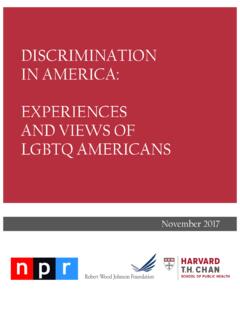Transcription of WHAT IS RACIAL DOMINATION? - Harvard University
1 STATE OF THE ARTWHAT IS RACIAL DOMINATION? Matthew DesmondDepartment of Sociology, University of Wisconsin MadisonMustafa EmirbayerDepartment of Sociology, University of Wisconsin MadisonAbstractWhen students of race and racism seek direction, they can find no single comprehensivesource that provides them with basic analytical guidance or that offers insights into theelementary forms of RACIAL classification and domination . We believe the field wouldbenefit greatly from such a source, and we attempt to offer one here. Synchronizing andbuilding upon recent theoretical innovations in the area of race, we lend some conceptualclarification to the nature and dynamics of race and RACIAL domination so that students ofthe subjects especially those seeking a general (if economical) introduction to the vastfield of race studies can gain basic insight into how race works as well as effective (andfallacious) ways to think about RACIAL domination .
2 Focusing primarily on the Americancontext, we begin by defining race and unpacking our definition. We then describe howour conception of race must be informed by those of ethnicity and nationhood. Next, weidentify five fallacies to avoid when thinking about racism. Finally, we discuss the resilienceof RACIAL domination , concentrating on how all actors in a society gripped by racismreproduce the conditions of RACIAL domination , as well as on the benefits and drawbacksof approaches that emphasize :Race, Race Theory, RACIAL domination , Inequality, IntersectionalityINTRODUCTIONS ynchronizing and building upon recent theoretical innovations in the area of race,we lend some conceptual clarification to the nature and dynamics of race and racialdomination, providing in a single essay a source through which thinkers especiallythose seeking a general~if economical!
3 Introduction to the vast field of race studies can gain basic insight into how race works as well as effective ways to think aboutracial domination . Unable to locate a single and concise essay that, standing alone,summarizes the foundational ideas of a critical sociology of race and racism, we wrotethis article to provide scholars and students with a general orientation or introduc-tion to the study of RACIAL domination . In doing so, we have attempted to lendDu Bois Review, 6:2(2009) 335 355. 2009 W. E. B. Du Bois Institute for African and African American Research 1742-058X009 $ clarity to the concept of race, as well as to its relationship with ethnicityand nationality. Perhaps more important, along with advancing a clear definition ofracial domination , we have identified five fallacies recurrent in many public debates that one should avoid when thinking about racism.
4 Although we believe this paperwill provide guidance for advanced scholars conducting empirical and theoreticalwork on race, we have composed it primarily with a broader audience in IS RACE?You do not come into this world African or European or asian ; rather, this worldcomes into you. As literally hundreds of scientists have argued, you are not born witha race in the same way you are born with fingers, eyes, and hair. Fingers, eyes, andhair are natural creations, whereas race is a social fabrication~Duster 2003; Graves2001!. We define race asa symbolic category, based on phenotype or ancestry and con-structed according to specific social and historical contexts, that is misrecognized as a definition deserves to be CategoryA symbolic category belongs to the realm of ideas, meaning-making, and language.
5 Itis something actively created and recreated by human beings rather than pregiven,needing only to be labeled. Symbolic categories mark differences between groupedpeople or things. In doing so, they actually bring those people or things into exis-tence~Bourdieu 2003!. For example, the term Native American is a symboliccategory that encompasses all peoples indigenous to the land that is known, today, asthe United States. But the term Native American did not exist before non-NativeAmericans came to the Americas. Choctaws, Crows, Iroquois, Hopis, Dakotas, Yaki-mas, Utes, and dozens of other people belonging to indigenous tribes existed. Theterm Native American flattens under one homogenizing heading the immenselydifferent histories, languages, traditional beliefs, and rich cultural practices of thesevarious tribes.
6 In naming different races, RACIAL categories create different insights into the importance of the symbolic have not always been appre-ciated. Consider, for example, Oliver Cromwell Cox s hypothesis that RACIAL exploi-tation and race prejudice developed among Europeans with the rise of capitalism andnationalism, and that because of the worldwide ramifications of capitalism, all racialantagonisms can be traced to the policies and attitudes of the leading capitalistpeople, the@W#hite people of Europe and North America ~1948, p. 322!. Thoughfew scholars today would agree fully with Cox s reduction, many continue to advancestructuralist claims, filtering RACIAL conflict through the logic of class conflict~ ,Reich 1981!, regarding RACIAL formation as a political strategy~ , Marx 1998!
7 ,orconcentrating on the legal construction of RACIAL categories~ , Haney-L pez1996!.3 Helpful as they are, structuralist accounts often treat race as something givenand accepted that is, as a real label that attaches itself to people~Bonilla-Silva1997!or as an imposed category that forms RACIAL identity~Marx 1998! and therebyoverlook how actors create, reproduce, and resist systems of RACIAL classification,dynamics documented in works such as Kimberly DaCosta sMaking Multiracials~2007!, Thomas Guglielmo sWhite on Arrival~2004!, John Jackson, Jr. sHarlemworld~2001!, Robin Sheriff sDreaming Equality~2001!, or John Hartigan, Jr. sRacial Situ-ations~1999!. Political and legal RACIAL taxonomies do not necessarily align withquotidian processes of recognition and identification practiced by classified subjectsMatthew Desmond and Mustafa Emirbayer336DU BOIS REVIEW: SOCIAL SCIENCE RESEARCH ON RACE 6:2, 2009~Loveman 1999!
8 Since no institution, regardless of its power, monopolizes thedefinition of race~Brubaker and Cooper, 2000!, we must resist assuming an easycorrespondence between official categorizations and the practical accomplish-ments of RACIAL or AncestryRace also is based on phenotype or ancestry. A person s phenotype is her or hisphysical appearance and constitution, including skeletal structure, height, hair tex-ture, eye color, and skin tone. A person s ancestry is her or his family lineage, whichoften includes tribal, regional, or national affiliations. The symbolic category of raceorganizes people into bounded groupings based on their phenotype, ancestry, orboth. It is difficult to say which matters more, phenotype or ancestry, in determiningracial membership in the United States.
9 In some settings, ancestry trumps pheno-type; in others, the opposite is immigrants often are pigeonholed in one of the dominant RACIAL catego-ries because of their phenotype; however, many resist this classification because oftheir ancestry. For instance, upon arriving in the United States, many first genera-tion West Indian immigrants, quite familiar with racism against African Americans,actively resist the label Black. Despite their efforts, many are considered AfricanAmerican because of their dark skin~that is, they look Black to the American eye!.The children of West African immigrants, many of whom are disconnected fromtheir parents ancestries, more readily accept the label Black ~Waters 1999!. Andmany individuals with mixed heritage often are treated as though they belonged onlyto one race.
10 Some people, by contrast, rely on their phenotype to form a RACIAL identity,though they are often grouped in another RACIAL category based on their Guillory Phipps, a blond-haired blue-eyed woman who always consideredherself White, discovered, upon glancing at her birth certificate while applying fora passport, that her native state, Louisiana, considered her Black. The reason wasthat Louisiana grouped people into RACIAL categories according to the one thirty-second rule, a rule that stated that anyone who was one thirty-second Black regardlessofwhattheylookedlike waslegally Black. In1982,SusieGuilloryPhippssued Louisiana for the right to be White. She lost. The state genealogist discoveredthat Phipps was the great-great-great-great-grandchild of a White Alabama planta-tion owner and his Black mistress and, therefore although all of Phipps s other ances-tors were White she was to be considered Black.













